More than 25,000 square feet of gallery space at the Modern Art Museum of Fort Worth are devoted to I’ll Be Your Mirror: Art and the Digital Screen (Feb. 12- April 30, 2023). Videos and digital work by 50 artists dating from the late 1960s to contemporary pieces by Caitlin Cherry, Simon Denny, Hasan Elahi, and Kahlil Robert Irving fill all eight of the upstairs galleries at the museum. According to exhibition curator Alison Hearst, this is the most in-depth show of its kind in the Southwest and one of only a handful that explore the effect of digital technology on art. Iconic works by prominent artists such as Nam June Paik, Andy Warhol, Gretchen Bender, and Cory Arcangel are on display, as well as several artists living in Texas—Liss LaFleur, Kristin Lucas, and John Pomara.
The show is organized into nine categories rather than being presented chronologically. The categories are: Liminal Space, Connectivity, The Repository, Surveillance, Digital Abstraction, The Posthuman Body, Automation and the Loneliness Epidemic, Ecology, and Turning the Mirror on Ourselves. “It was a challenge to organize the videos into these categories, as many of them fit into more than one,” Hearst said.
Two trailblazing artists, the Korean-American artist Nam June Paik (1932–2006) and the American artist Lillian F. Schwartz (b. 1927), were among those making innovations in art and technology in the late 1960s and early 1970s. Paik, often referred to as the “father of video art,” is represented by the familiar Video Flag Y (1985) consisting of 84 television sets displayed in a modular cabinet. It is part of Liminal Space, which includes pioneering artists who experimented with the new medium. Schwartz is represented by Mutations (1972), a nearly seven-minute video with shifting abstract shapes moving in concert to an electronic musical score.
Bender (1951-2004) was another prescient artist and innovator. In Total Recall (1987), she inundates the audience with a barrage of flashing images on 24 monitors and three projection screens—people on escalators and crowded streets, trees being blown by the wind, and advertisements—as an early comment on information overload.
The section on Connectivity includes younger artists who grew up playing video games and collaborating with other artists. As an example, Wickerham and Lomax produced Lovers Interfacing Between Home and the Moon during the pandemic, passing the image back and forth and augmenting it using the software Blender. LaFleur is a transmedia artist whose work explores the relationships of gender, technology, and identity. Her piece focuses on activist Stormé DeLarverié, whom some say threw the first punch in the Stonewall Riots in 1969 but has been left out of many accounts.
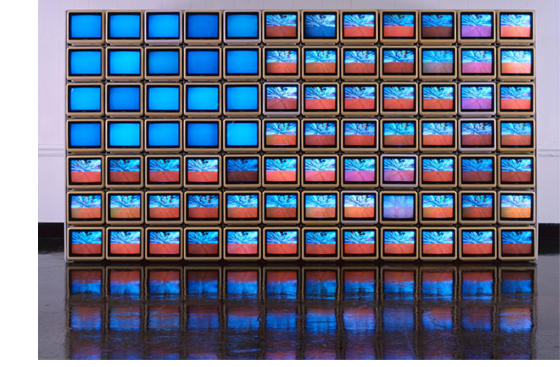
1 ⁄10
Nam June Paik, Video Flag Y, 1985. 84 ten-inch television sets, three Plexiglas cases, fans, LaserDisc players, LaserDiscs, and video tapes. 72 x 144 x 50 inches. JPMorgan Chase Art Collection © Estate of Nam June Paik
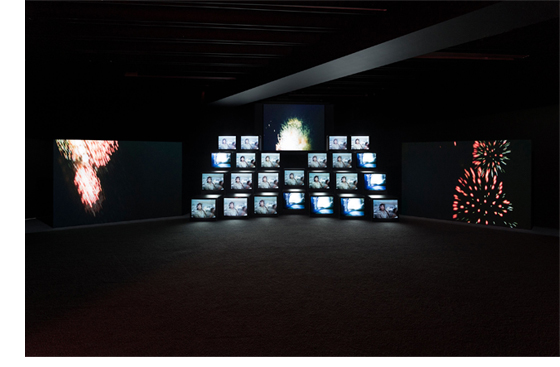
2 ⁄10
Gretchen Bender, Total Recall, 1987. Eight-channel video on 24 monitors and three rear projection screens; 18 minutes, 2 seconds. Installation view, Red Bull Arts New York, March 6–July 28, 2019. Courtesy the Gretchen Bender Estate and Sprüth Magers. © Gretchen Bender Estate. Photo: Lance Brewer
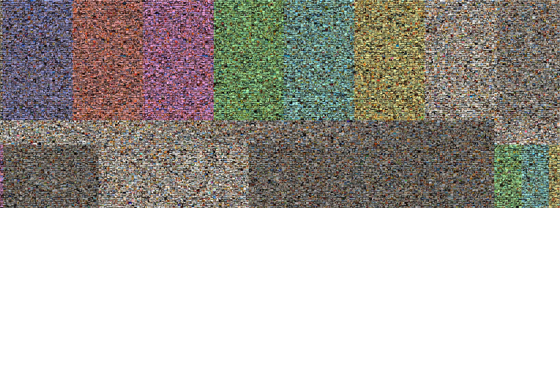
3 ⁄10
Hasan Elahi, Thousand Little Brothers v8, 2022. Pigment print. 192 inches x 612 ½ inches. Courtesy of the Artist and C. Grimaldis Gallery. © Hasan Elahi
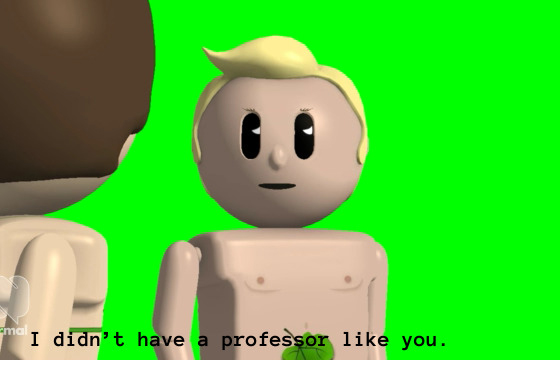
4 ⁄10
Frances Stark, My Best Thing, 2011 (video still). Video, projection, and sound; 1 hour, 39 minutes. Courtesy of the Artist and Gladstone Gallery. © Frances Stark
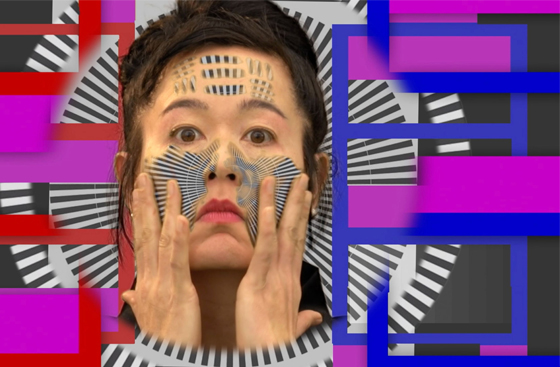
5 ⁄10
Hito Steyerl, How Not to Be Seen: A Fucking Didactic Educational .MOV File, 2013 (film still). Single-channel high-definition digital video and sound in architectural environment; 15 minutes, 52 seconds. Courtesy of the Artist, Andrew Kreps Gallery, New York and Esther Schipper, Berlin. © VG Bild-Kunst, Bonn 2022. Film still © Hito Steyerl
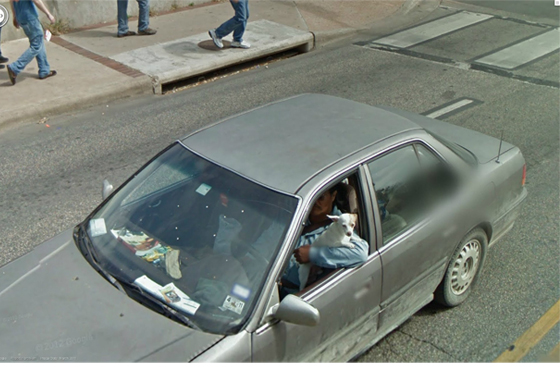
6 ⁄10
Jon Rafman, 378 Texas 343 Loop, Austin, Texas, United States from Nine Eyes of Google Street View, 2013. Photographic print. 40 x 64 inches. Courtesy the Artist and Sprüth Magers. © Jon Rafman
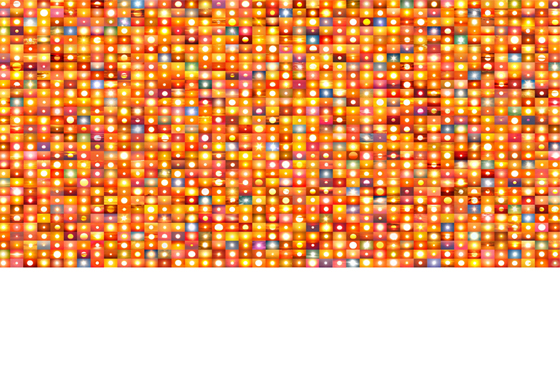
7 ⁄10
Penelope Umbrico
48,586,054 Suns from Sunsets from Flickr (Partial), 2020
Wall installation of 1,440 photographs
20 x 270 inches
Courtesy the Artist, David B. Smith Gallery, and Thoma Foundation
© Penelope Umbrico
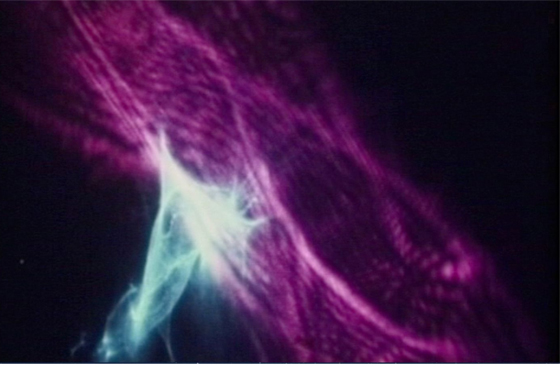
8 ⁄10
Lillian F. Schwartz
Mutations, 1972
16 mm, color, and sound (digitized)
7 minutes, 30 seconds
The Henry Ford

9 ⁄10
Liss LaFleur
Queen Bee is Stinging Mad, 2019
HD animation, surround sound:
33 minutes, 33 seconds
Galleri Urbane Marfa + Dallas
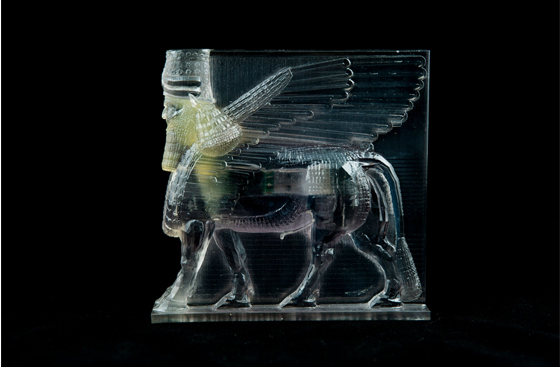
10 ⁄10
Morehshin Allahyari
Lamassu
from the series Material Speculation: ISIS, 2015
3D-printed resin and electronics components
6.25 x 6.25 x 1.25 inches
©Morehshin Allahyari
Today’s overwhelming torrent of information facilitated by the ubiquitous smartphone is the focus of artists in the Repository section. Commenting on the vast array of images and information bombarding our lives are Morehshin Allahyari, Kahlil Robert Irving, Trevor Paglen, Jason Salavon, Skawennati, and Penelope Umbrico. Skawennati has created an animated series inside the online world Second Life, but she is aware of the inherent dangers that exist online. “The internet held so much promise as an information highway to make everyone’s lives better,” she said, “but it has turned out to be a place where it’s difficult to find the truth, where our privacy is threatened, and our relationship with it has become commodified.”
In the final section, Turning a Mirror on Ourselves, Arthur Jafa and Molly Soda use found videos to comment on the social milieu, with Jafa probing America’s race relations and Soda creating a sense of community among disparate online users. As Hearst writes, “The artists exhibited in ‘I’ll Be Your Mirror’ are indeed the exhibition’s most significant mirrors, reflecting the social, political, and technological advancements and dangers of the past five decades.”
The exhibition, and its daunting installation, is “truly a labor of love” according to Hearst. It surveys and categorizes 50 years of digital-based and digitally influenced works of art. The medium continues to evolve, exerting a powerful influence on the present and fueling the future. As Dr. Suler concludes, “In cyberspace we can reveal, find, integrate, distort, create or lose ourselves. The choice is ours.”
—DONNA TENNANT




